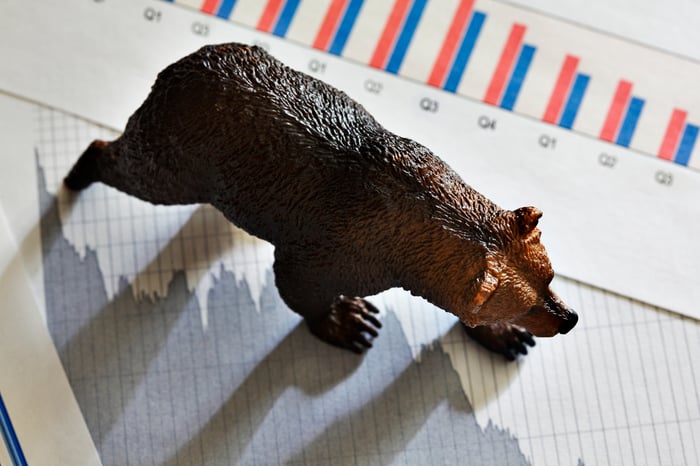One of the few guarantees investors are given on Wall Street is the assurance of short-term unpredictability. Since the start of 2021, we've witnessed three vastly different stock markets.
In 2021, the ageless Dow Jones Industrial Average (^DJI 0.40%), benchmark S&P 500 (^GSPC 1.02%), and growth-dependent Nasdaq Composite (^IXIC 2.02%) all motored to multiple record-closing highs. This was followed in 2022 by the Dow, S&P 500, and Nasdaq Composite plunging into a bear market and producing their worst full-year returns since 2008. In 2023, Wall Street is roaring once more, albeit a relatively small group of high-growth, megacap stocks are responsible for virtually all of this year's gains.

Image source: Getty Images.
By one measure, the S&P 500 and Nasdaq Composite have entered a new bull market. With both indexes rallying more than 20% off of their 2022 bear market lows, the bulls are proudly displaying their horns. But if one widely followed economic indicator has its say, declaring a new bull market looks to be premature.
This economic indicator hasn't been wrong in 30 years
While there is no shortage of high-profile economic indicators reported on a weekly or monthly basis, the one that should have investors paying closing attention is U.S. retail sales.
U.S. retail sales encompasses the sale of finished goods (durable or perishable) from businesses to consumers. As you can imagine, this includes a wide gamut of spending categories, including apparel, furniture, electronics, groceries, and so on. The year-over-year or month-over-month increase or decrease in U.S. retail sales can tell us how healthy the U.S. economy is, as well as offer insights into the discretionary spending power of consumers. In other words, are consumers using their cash or credit to making non-necessary purchases?
Although U.S. retail sales growth probably isn't raising any eyebrows on a nominal basis, things get a bit dicey when adjusted for inflation -- i.e., the rising cost of goods and services.
(5) US Consumer Is Pulling Back
-- Charlie Bilello (@charliebilello) June 21, 2023
After adjusting for inflation, US retail sales fell 3.3% over the last year, the 7th consecutive YoY decline. That's the longest down streak since 2009.
Video: https://t.co/SxMJ49yW32 pic.twitter.com/ZK38nzh1VV
As you can see in the tweet above from Charlie Bilello, the chief market strategist at wealth management firm Creative Planning, U.S. retail sales have declined for seven consecutive months, on a year-over-year basis, when adjusted for inflation. Even though U.S. retail sales have been nominally higher, they've actually declined when the above-average U.S. inflation rate is factored in. This inflation-adjusted performance is known as U.S. "real" retail sales.
To be clear, we've witnessed a number of instances where real retail sales have moved modestly lower over a one- or two-month stretch since 1993. But there have only been a handful of times where U.S. real retail sales were predominantly negative for an extended period: a majority of the months between Jan. 2001 through Oct. 2001; from Jan. 2008 through Dec. 2009; and over the past seven months.
What do the previous two lengthy declines in U.S. real retail sales have in common? They saw the benchmark S&P 500 plunge by a peak of 49% and 57%, respectively. While the 2022 bear market did see the S&P 500 fall by as much as 28% on an intra-day basis, a continued decline in real retail sales doesn't bode well for the U.S. economy or stock market.
A persistent decline in real retail sales is far from the only ominous warning
The concern for Wall Street is that weaker real retail sales isn't the only economic outlier. While handfuls of positive signs can be found, such as the persistently low unemployment rate and a surge in U.S. housing starts in May, a few fundamentally important metrics suggest trouble to come for the U.S. economy.
US Commercial Banks Bank Credit data by YCharts.
A good example is what's happening with commercial bank lending in the U.S. While there have been dozens of blips lower in commercial bank lending over the past 50 years, there are only four occasions where commercial bank lending has fallen at least 1.5% from an all-time high.
The previous three times banks tightened their lending standards and commercial bank credit declined by more than 1.5%, the S&P 500 lost around half of its value. And yes, two of those three previous instances included the dot-com bubble bursting and the financial crisis, which means tighter lending standards at commercial banks coincided with a persistent drop in U.S. real retail sales.
As of the week ended June 16, commercial bank credit had declined 1.95% in a span of three months (i.e., since the short-lived regional-banking crisis). If banks are visibly tightening their lending standards, historically that means bad news for the economy and the stock market.
WARNING: the Money Supply is officially contracting. 📉
-- Nick Gerli (@nickgerli1) March 8, 2023
This has only happened 4 previous times in last 150 years.
Each time a Depression with double-digit unemployment rates followed. 😬 pic.twitter.com/j3FE532oac
Sticking with money as an important indicator, M2 money supply is declining for the first time since the Great Depression. M2, which accounts for everything in M1 (e.g., cash, coins, and demand deposits in a checking accounts) and adds savings accounts, money market funds, and certificates of deposit (CDs) under $100,000, has fallen 4.8% from its all-time high set in July 2022.
On the one hand, a 4.8% drop in M2 could be relatively benign given that M2 expanded by a record 26% in a single year during the COVID-19 pandemic. Stimulus checks and pandemic-related programs flooded the U.S. economy and consumers' pockets with cash. What we're seeing now could be a reversion to the mean.
Then again, declining money supply with above-average inflation has often been a recipe for disaster. Over the past 153 years, instances where M2 fell by more than 2% led to deflationary recessions and high unemployment rates.
Even though economic downturns tend to be short-lived, history shows that stock losses tend to be their most severe in the months after an official recession is declared. While this isn't a written-in-stone rule, it does suggest that the "new" bull market may be nothing more than an outsized bear market rally.

Image source: Getty Images.
Trust in the power of the bull market over the long run
If you were to twist my arm and ask me to pick which direction I believe the Dow Jones, S&P 500, and Nasdaq Composite will head over the next six months, I'd choose down. Weaker real retail sales, declining M2, a tightening credit climate, more than a year of the Conference Board Leading Economic Index (LEI) declining, and poor market breadth paint a pretty clear picture of a challenged economy and a stock market that doesn't appear to be reflecting these challenges.
But the reality is that I could be flat-out wrong. Trying to predict the directional movement in stocks over the short run is exceptionally difficult to do with any consistency. It's why there's no such thing as a foolproof economic indicator or metric.
However, investors have been able to count on bull markets, with confidence, over the long run.
Take a look at the chart above of the iconic Dow Jones Industrial Average. This 93-year chart of Wall Street's most beloved stock index contains a nearly 90% plunge endured during the Great Depression, as well as Black Monday in 1987, which saw the Dow lose more than 22% of its value in a single session. These historically bearish events are barely even visible on the long-term chart today.
The reason why is simple: The U.S. economy, and the collective businesses that make up the U.S. economy, grow in value over long periods. The Dow is composed of 30 mature, generally profitable, multinational companies that are able to take advantage of the expansion of the U.S. and global economy over many decades. It's why every single stock market correction and bear market in all three major U.S. stock indexes has eventually been wiped away by a bull market.
Although we'll never know with any certainty what the stock market is going to do tomorrow or even a year from now, history is pretty clear that betting on equities to outperform over a period of 20 or more years is a winning strategy.






